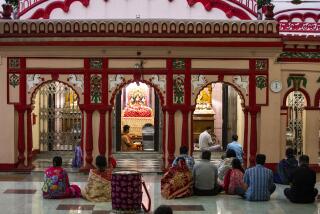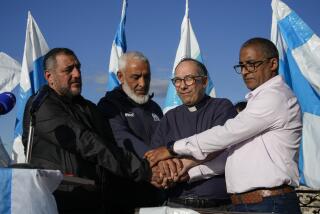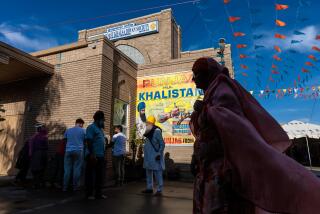Wide Gulf of Ignorance and Fear Divides the Peoples of India, Pakistan
ISLAMABAD, Pakistan — When Farida Ahmad crossed India’s border for the first time, she recalls, some Indians were amazed she wasn’t wearing a veil. They had heard that all Muslim women in Pakistan were kept hidden by their men.
When she returned, Pakistani friends were just as astounded to learn she had seen no evidence that Hindu caste prejudices rule life in the Indian city of Calcutta.
Ahmad, an Islamabad businesswoman, had crossed the gulf of ignorance that separates residents of Pakistan from their counterparts in neighboring India. Their governments have been rivals since both nations won independence from Britain in 1947; three times, the hostility has flared into war.
“The picture that has been created in India about Pakistanis, and for that matter in Pakistan about Indians, is that the others are demons,” said Ahmad, who is active in a private group working in both countries to promote better relations.
In a sign of the tensions, cross-border visits under the group’s umbrella have been allowed only twice, for a meeting held in Pakistan in 1995 and for the Calcutta meeting Ahmad attended in 1996. Generally, each country is stingy with visas for the other’s citizens, citing fear of terrorism.
Visas may be one issue on the agenda when diplomats restart negotiations soon on various disputes. The talks broke down three years ago. Changes of government in both India and Pakistan within the last year have given rise to hopes for a thaw in their cold war.
“The only images we get of each other are secondhand images,” said Tariq Rahman, a Pakistani linguist. Although an expert in Indian as well as Pakistani languages, he has never been granted permission to visit India.
The result in Pakistan, Rahman said, is that his countrymen rarely question official propaganda that claims India never accepted the partition of the old British empire in southern Asia and wants to take Pakistan back--starting with Kashmir.
Although such Indian leaders as Jawaharlal Nehru resisted partition, India officially accepted it and recognizes Pakistan as a sovereign country.
Every January in Pakistan brings Kashmir Solidarity Day, a national holiday on which Pakistanis are asked to remember the Muslim region both countries claim and is now divided between them.
This year, state television broadcast video of Kashmiri homes allegedly set ablaze by Indian “occupation” troops, undercutting a Foreign Ministry announcement the day before that Pakistan sought better relations with India.
Fear of India must be overcome, Rahman said.
“It is, in fact, a development issue, because the money [that] we and India both spend on development is abysmal,” he said. “If we were to take money from defense and spend it on development, it could mean a lot for the entire region.”
The United Nations, in a study of government spending for 1990-1995, found Pakistan devoted just 1% of its budget to health and 2% to education, while 31% went to the military. In much more populous India, health and education each got 2% and the military got 15%.
Much of the money goes for nuclear weapons research, which both India and Pakistan say they must pursue to protect themselves.
S. Dasgupta, a retired New Delhi museum caretaker, said those who are now Indians and those who are now Pakistanis once “lived together in a brotherly way,” without missiles capable of carrying nuclear warheads pointed at each other.
But Muslim leaders in 1947 argued their people would be discriminated against in overwhelmingly Hindu India and insisted on their own country.
And in the years before partition, debate over whether Hindus and Muslims could live together fanned religious violence.
“There were countless bodies floating in the rivers. The jackals couldn’t eat all the bodies, there were too many,” said Dasgupta, a Hindu who fled what was then East Pakistan--now independent Bangladesh--when he was a teenager.
“‘Pakistan is only for Muslims, not Hindus’; that was the slogan,” Dasgupta said.
His family abandoned their farm and started again in India. He remembers thousands of Hindus headed to India meeting thousands of Muslims headed in the other direction at the India-Pakistan border.
Hindu-Muslim violence continues in India, whose 950 million people include about 104 million Muslims--almost as many as Pakistan’s predominantly Muslim population of 130 million.
Dasgupta’s daughter, Aradhana Majumdar, said she tries not to let her parents’ memories color her perceptions. She believes tensions have been kept alive to distract ordinary people from failed policies that have left both India and Pakistan among the world’s poorest countries.
“If our leaders came here and told us Pakistan was going to drop a nuclear bomb on us, of course we would be afraid. And that’s what the Pakistanis hear about India--that India wants to attack,” Majumdar said. “Politicians on both sides are more interested in keeping their positions than they are in the future of their countries.”
India was not a unified state when the British arrived. The region was a collection of princely states, some ruled by Hindus and some by Muslims.
But Rajiv Vora, a researcher at the Gandhi Peace Foundation in New Delhi, India’s capital, said the Muslims’ demand for partition of British India convinced many Hindus of Muslim religious prejudice.
Now, he said, both Indians and Pakistanis need to put their differences behind them and work for the ideal of independence leader Mohandas K. Gandhi, who envisioned the new India as a loose federation of states in which Hindus, Muslims and other groups could coexist and prosper.
“We didn’t achieve freedom to gain small political advantages over each other,” Vora said. “We had larger dreams, and we still have. I’m sure [the] people of Pakistan also still have larger dreams, because we once dreamed together as one people.”
More to Read
Sign up for Essential California
The most important California stories and recommendations in your inbox every morning.
You may occasionally receive promotional content from the Los Angeles Times.










